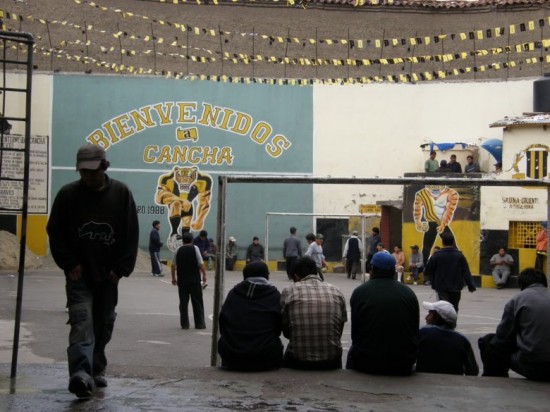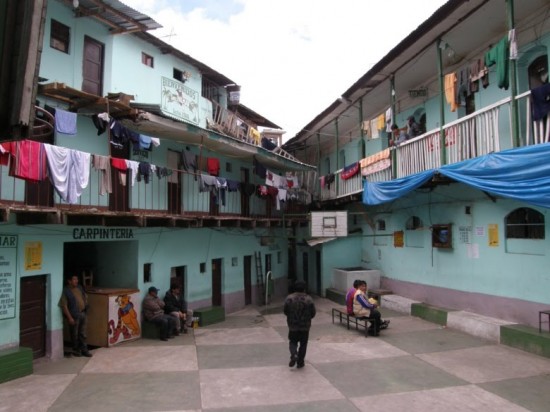Overview
This post explores how inmates govern themselves in San Pedro Prison in La Paz, Bolivia. I have drawn heavily on David Skarbek’s article “Self-Governance in San Pedro Prison.” As a general matter, the largest obstacle to self-governance in prison is that prisoners cannot leave if they dislike the prison’s governance. However, this obstacle has not prevented the inmates at San Pedro Prison from governing themselves. Several features of San Pedro Prison foster self-governance: prisoners can engage in economic activity, non-prisoners can enter into the prison, property rights and markets are well-established, and homeowners’ associations and dispute resolution committees resolve conflicts between inmates.
Features of San Pedro Prison
San Pedro Prison was designed to hold 250 inmates but it now houses 1,300 to 1,500 inmates. Most inmates live in city-style housing; there are few cells or bars in the prison. Inmates are not assigned to a housing space, but instead purchase or lease housing upon their arrival. Inmates can move freely within the prison.
The prison guards only prevent inmates from escaping; guards do not protect inmates from each other. The guards allow outsiders to enter the prison for a small fee. These outsiders may engage in economic activity with the prisoners or even tour the prison for approximately $35 USD. The tours last 2 hours and tours are given to 50 people per day. Furthermore, tourists can stay in the prison overnight for an additional fee. Tourists are safe while in the prison – there has only been one reported incident in which a tourist was pickpocketed, and the tourist’s wallet was later returned.
Wives and children of inmates can live in the prison. Approximately 200 children live in the prison for most of the year, while nearly 400 children live in the prison around Christmas. A parents’ association prevents violence against children. Moreover, inmates do not fight in the presence of children and they even stop fighting when children walk by.

Children inside San Pedro Prison
Social and Legal Organization within San Pedro Prison
San Pedro Prison is divided into eight housing sections. “Representatives of each housing section manage their communities much as a neighborhood association does—adjudicating disputes, providing ‘club’ goods, and organizing community activities. Inmates campaign for positions in each housing section, including positions as representative, treasurer, discipline secretary, culture and education secretary, sports secretary, and health secretary.” (David Skarbek)
Welfare exists within the prison. The Catholic Church provides blankets, food, clothing, and medical care to new and impoverished inmates. A reception committee welcomes new prisoners, finds them housing, explains the rules of the prison.
Disputes are resolved by the elected leaders of each housing section. The punishments for harming other residents include being beat with sticks, sent to isolation cells that are more akin to a traditional prison cell, and transferred to a maximum security prison (Chonchocorro Prison) that is more violent and more restrictive than San Pedro Prison.
The Prison Economy
Inmates must work to survive because they must pay for their own housing and because the Bolivian government does not provide all of the goods and services necessary for survival. The prison provides rotten food and inadequate healthcare so inmates sell food and health services to other inmates. Occupations inside San Pedro Prison include lawyers, electricians, cooks, cleaners, accountants, doctors, artists, and carpenters.
The economy expands outside the walls of the prison. Women and children facilitate market transactions between inmates and the outside world. Outsiders may also enter into the prison (for a fee to the guards) to buy cheap goods and services from the inmates. Some inmates manufacture narcotics to sell within the prison and outside of the prison, transported by women and children.
Because inmates own their housing space (or rent it from an owner), they are incentivized to keep their property and shared housing section clean and safe. More expensive units do not allow drug use and lock out all outsiders at night. Some units have televisions, refrigerators, microwaves, stoves – and one even has a piano. Housing committees charge dues to maintain the communal spaces and to put on social events, such as soccer matches. The Coca Cola Company even sponsors some soccer matches between housing sections so that the Company can have a monopoly on beverages during the matches.

A soccer match in San Pedro Prison
Violence in the Prison
Most of the violence in San Pedro Prison occurs between drug addicts or when inmates do not pay their debt. Deaths do occur within the prison. Women and children are also at risk of physical and sexual assault, but homeowners’ associations and the parents’ association prevents most of such violence.
References and Photos
“Self-Governance in San Pedro Prison” by David Skarbek
Oddity Central Article
BBC Article
